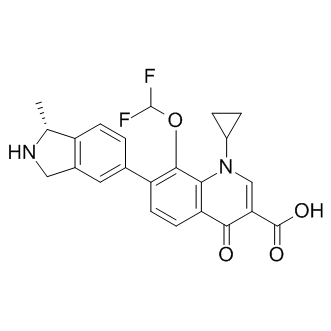
Garenoxacin
CAS No. 194804-75-6
Garenoxacin( BMS284756 | BMS 284756 | BMS-284756 | Garenoxacin. tradename Geninax )
Catalog No. M13048 CAS No. 194804-75-6
A quinolone antibiotic for the treatment of Gram-positive and Gram-negative bacterial infections.
Purity : >98% (HPLC)
 COA
COA
 Datasheet
Datasheet
 HNMR
HNMR
 HPLC
HPLC
 MSDS
MSDS
 Handing Instructions
Handing Instructions
| Size | Price / USD | Stock | Quantity |
| 2MG | 46 | In Stock |


|
| 5MG | 67 | In Stock |


|
| 10MG | 91 | In Stock |


|
| 25MG | 165 | In Stock |


|
| 50MG | 257 | In Stock |


|
| 100MG | 386 | In Stock |


|
| 200MG | Get Quote | In Stock |


|
| 500MG | Get Quote | In Stock |


|
| 1G | Get Quote | In Stock |


|
Biological Information
-
Product NameGarenoxacin
-
NoteResearch use only, not for human use.
-
Brief DescriptionA quinolone antibiotic for the treatment of Gram-positive and Gram-negative bacterial infections.
-
DescriptionA quinolone antibiotic for the treatment of Gram-positive and Gram-negative bacterial infections.Bacterial Infection Approved.
-
In VitroGarenoxacin (BMS284756) (0-8 days) inhibits mycoplasmas and ureaplasmas with MIC90s ≤0.25 μg/mL against tested strains.Garenoxacin (48 h) inhibits S. aureus wild type and mutants with MICs of 0.0128-4.0 μg/mL. Garenoxacin inhibits topoisomerase IV and gyrase from S. aureus with IC50s of 1.25 to 2.5 and 1.25 μg/mL, respectively.Garenoxacin has a low propensity for selective enrichment of fluoroquinolone-resistant mutants among ciprofloxacin-susceptible isolates of S. aureus. :Cell Viability Assay Cell Line:M. pneumonia, M. fermentans, M. hominis and Ureaplasma spp.Concentration:Incubation Time:24 h for Ureaplasma spp., 48 h for M. hominis, 4 to 8 days for M. pneumonia Result:Showed inhibition with MIC90s of 0.031 μg/mL, ≤0.008 μg/mL, ≤0.008 μg/mL and 0.25 μg/mL against M. pneumonia, M. fermentans, M. hominis and Ureaplasma spp. strains, respectively.
-
In VivoGarenoxacin (12.5-50 mg/kg; s.c.; once) is highly effective against the wild-type strain and mutants harboring a single mutation in a mouse pneumonia model with S. pneumonia infection.Garenoxacin (10 and 30 mg/kg; p.o.; once) reduces the viable cell counts in the lungs and significantly prolongs survival on experimental secondary pneumococcal pneumonia caused by S. pneumoniae D-979 in BALB/c female mice. Animal Model:Swiss mice with S. pneumonia infection.Dosage:12.5, 25 and 50 mg/kg Administration:Subcutaneous injection, once Result:Significantly improved the survival rate.
-
SynonymsBMS284756 | BMS 284756 | BMS-284756 | Garenoxacin. tradename Geninax
-
PathwayGPCR/G Protein
-
TargetAntibacterial
-
RecptorAntibacterial
-
Research AreaInfection
-
IndicationBacterial Infection
Chemical Information
-
CAS Number194804-75-6
-
Formula Weight426.4127
-
Molecular FormulaC23H20F2N2O4
-
Purity>98% (HPLC)
-
Solubility10 mM in DMSO
-
SMILESO=C(C1=CN(C2CC2)C3=C(C=CC(C4=CC5=C([C@@H](C)NC5)C=C4)=C3OC(F)F)C1=O)O
-
Chemical Name3-Quinolinecarboxylic acid, 1-cyclopropyl-8-(difluoromethoxy)-7-[(1R)-2,3-dihydro-1-methyl-1H-isoindol-5-yl]-1,4-dihydro-4-oxo-
Shipping & Storage Information
-
Storage(-20℃)
-
ShippingWith Ice Pack
-
Stability≥ 2 years
Reference
molnova catalog



related products
-
G0507
G 0507 is a novel inhibitor of the bacterial LolCDE ABC transporter, binds to LolCDE and stimulates its ATPase activity.
-
Cefonicid sodium
Cefonicid sodium is a broadspectrum cephalosporin antibiotic which inhibits the formation of the bacterial cell wall.
-
Totarol
Totarol shows antibacterial effects against several pathogenic Gram-positive bacteria, mycobacterium tuberculosis.



 Cart
Cart
 sales@molnova.com
sales@molnova.com


